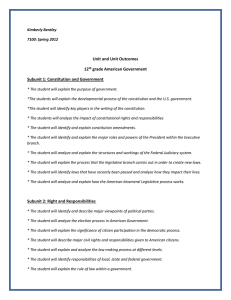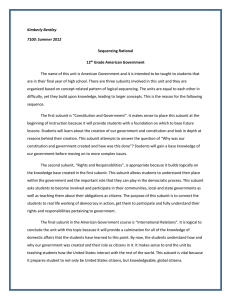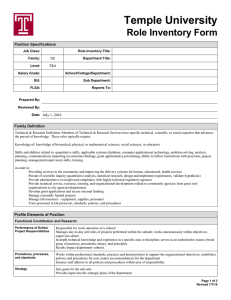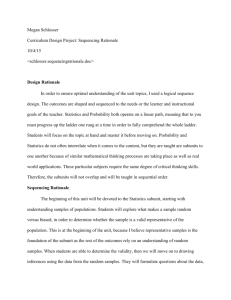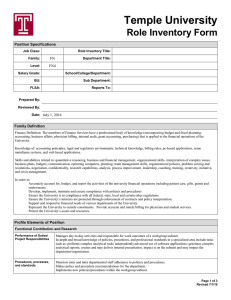BUiUUAELj LETTERS
advertisement
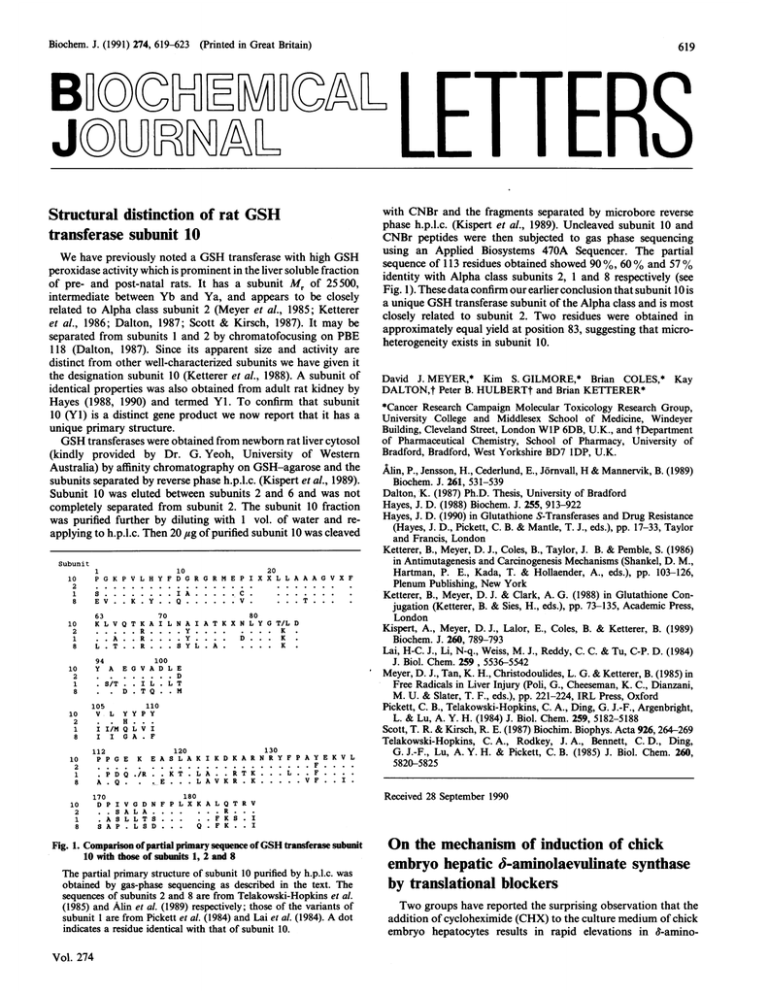
Biochem. J. (1991) 274, 619-623 (Printed in Great Britain) 619 BUiUUAELj LETTERS Structural distinction of rat GSH transferase subunit 10 We have previously noted a GSH transferase with high GSH peroxidase activity which is prominent in the liver soluble fraction of pre- and post-natal rats. It has a subunit Mr of 25500, intermediate between Yb and Ya, and appears to be closely related to Alpha class subunit 2 (Meyer et al., 1985; Ketterer et al., 1986; Dalton, 1987; Scott & Kirsch, 1987). It may be separated from subunits 1 and 2 by chromatofocusing on PBE 118 (Dalton, 1987). Since its apparent size and activity are distinct from other well-characterized subunits we have given it the designation subunit 10 (Ketterer et al., 1988). A subunit of identical properties was also obtained from adult rat kidney by Hayes (1988, 1990) and termed Y1. To confirm that subunit 10 (Y1) is a distinct gene product we now report that it has a unique primary structure. GSH transferases were obtained from newborn rat liver cytosol (kindly provided by Dr. G. Yeoh, University of Western Australia) by affinity chromatography on GSH-agarose and the subunits separated by reverse phase h.p.l.c. (Kispert et al., 1989). Subunit 10 was eluted between subunits 2 and 6 and was not completely separated from subunit 2. The subunit 10 fraction was purified further by diluting with 1 vol. of water and reapplying to h.p.l.c. Then 20 ,ug of purified subunit 10 was cleaved Subunit 20 1 10 P G K P V L H Y F D G R G R M E P I X X L L A A A G V X F 10 2 1 8 E V 10 2 1 8 80 70 63 K L V Q T K A I L N A I A T K X N L Y G T/L D .R Y .L... . . K ... Y. D .. K Y A .R . . ...... S Y L A ..... K L . T . . R . . . . . . . . . . . . I A Q . . . . . . . C .....V . . . . . . . . . . ... . . . . .... . . . . . . . . . . . . ... 100 E G V A D L E .D .S/T. .I L .L T D .T Q . .M 94 Y A 10 2 1 8 10 2 1 8 . Y . EV..K..K . 105 V L 10 2 1 8 10 2 1 8 Y Y P H . . I I/M Q L V I I G A . 112 P P G E K 110 Y . I F 130 120 E A S L A K I K D K A R N R Y F P A Y E K V L ...F .PDQ./R..KT.LA.RTK...L..F A .Q. . . . L A V K R 180 170 D P I V G D N F P L X K A L ... .. S A L A .... . F A S L L T S . S A P . L S D . Q . F . K .... . V F .. . . David J. MEYER,* Kim S. GILMORE,* Brian COLES,* Kay DALTON,t Peter B. HULBERTt and Brian KETTERER* *Cancer Research Campaign Molecular Toxicology Research Group, University College and Middlesex School of Medicine, Windeyer Building, Cleveland Street, London WIP 6DB, U.K., and tDepartment of Pharmaceutical Chemistry, School of Pharmacy, University of Bradford, Bradford, West Yorkshire BD7 lDP, U.K. Alin, P., Jensson, H., Cederlund, E., J6rnvall, H & Mannervik, B. (1989) Biochem. J. 261, 531-539 Dalton, K. (1987) Ph.D. Thesis, University of Bradford Hayes, J. D. (1988) Biochem. J. 255, 913-922 Hayes, J. D. (1990) in Glutathione S-Transferases and Drug Resistance (Hayes, J. D., Pickett, C. B. & Mantle, T. J., eds.), pp. 17-33, Taylor and Francis, London Ketterer, B., Meyer, D. J., Coles, B., Taylor, J. B. & Pemble, S. (1986) in Antimutagenesis and Carcinogenesis Mechanisms (Shankel, D. M., Hartman, P. E., Kada, T. & Hollaender, A., eds.), pp. 103-126, Plenum Publishing, New York Ketterer, B., Meyer, D. J. & Clark, A. G. (1988) in Glutathione Conjugation (Ketterer, B. & Sies, H., eds.), pp. 73-135, Academic Press, London Kispert, A., Meyer, D. J., Lalor, E., Coles, B. & Ketterer, B. (1989) Biochem. J. 260, 789-793 Lai, H-C. J., Li, N-q., Weiss, M. J., Reddy, C. C. & Tu, C-P. D. (1984) J. Biol. Chem. 259, 5536-5542 Meyer, D. J., Tan, K. H., Christodoulides, L. G. & Ketterer, B. (1985) in Free Radicals in Liver Injury (Poli, G., Cheeseman, K. C., Dianzani, M. U. & Slater, T. F., eds.), pp. 221-224, IRL Press, Oxford Pickett, C. B., Telakowski-Hopkins, C. A., Ding, G. J.-F., Argenbright, L. & Lu, A. Y. H. (1984) J. Biol. Chem. 259, 5182-5188 Scott, T. R. & Kirsch, R. E. (1987) Biochim. Biophys. Acta 926, 264-269 Telakowski-Hopkins, C. A., Rodkey, J. A., Bennett, C. D., Ding, G. J.-F., Lu, A. Y. H. & Pickett, C. B. (1985) J. Biol. Chem. 260, 5820-5825 0 .... .I. Q T R V Received 28 September 1990 R ... K S .I K . .I Fig. 1. Comparison of partial primary sequence of GSH transferase subunit 10 with those of subunits 1, 2 and 8 The partial primary structure of subunit 10 purified by h.p.l.c. was obtained by gas-phase sequencing as described in the text. The sequences of subunits 2 and 8 are from Telakowski-Hopkins et al. (1985) and Alin et al. (1989) respectively; those of the variants of subunit 1 are from Pickett et al. (1984) and Lai et al. (1984). A dot indicates a residue identical with that of subunit 10. Vol. 274 with CNBr and the fragments separated by microbore reverse phase h.p.l.c. (Kispert et al., 1989). Uncleaved subunit 10 and CNBr peptides were then subjected to gas phase sequencing using an Applied Biosystems 470A Sequencer. The partial sequence of 113 residues obtained showed 90 %, 60 % and 57 % identity with Alpha class subunits 2, 1 and 8 respectively (see Fig. 1). These data confirm our earlier conclusion that subunit 10 is a unique GSH transferase subunit of the Alpha class and is most closely related to subunit 2. Two residues were obtained in approximately equal yield at position 83, suggesting that microheterogeneity exists in subunit 10. On the mechanism of induction of chick embryo hepatic 6-aminolaevulinate synthase by translational blockers Two groups have reported the surprising observation that the addition of cycloheximide (CHX) to the culture medium of chick embryo hepatocytes results in rapid elevations in s-amino-
